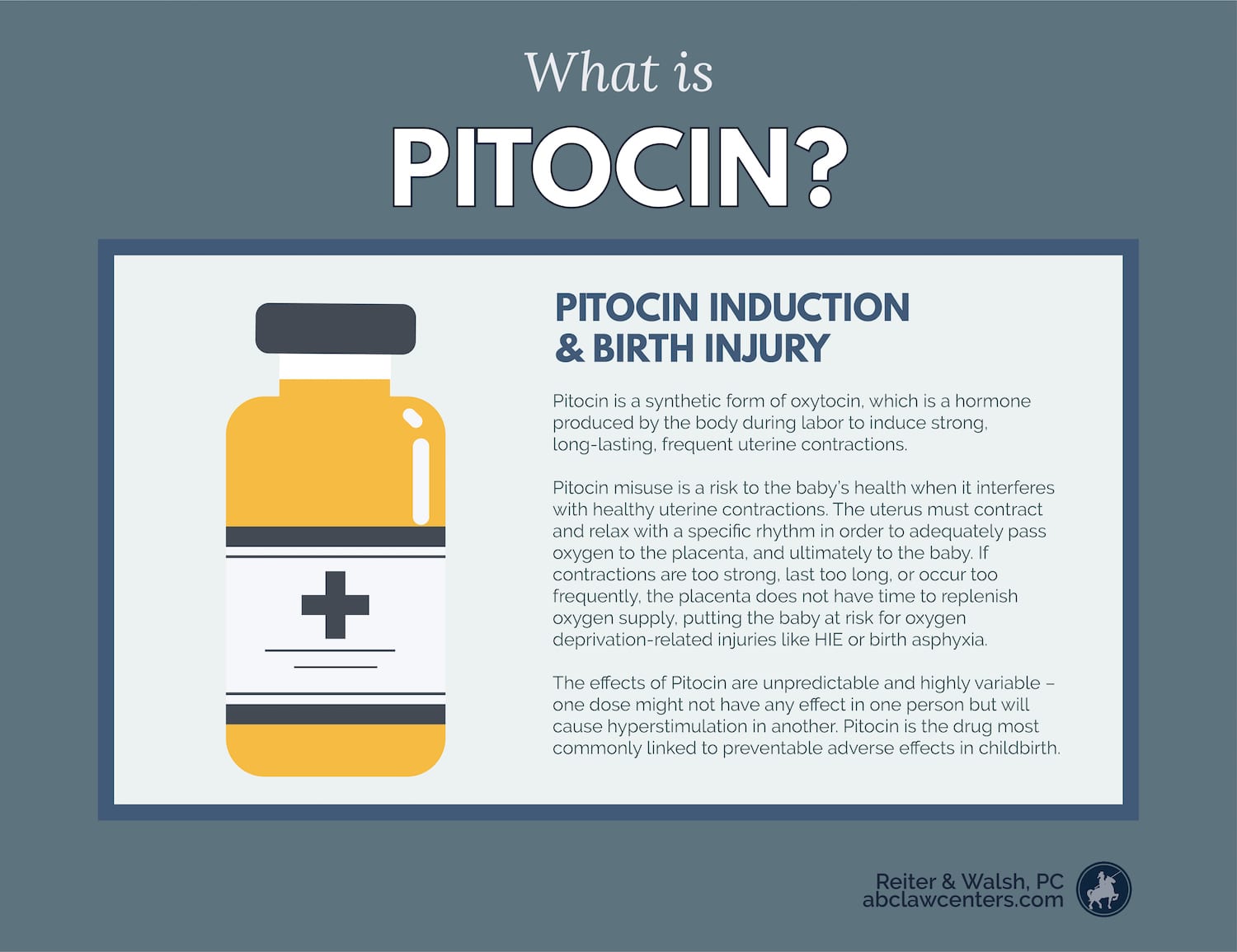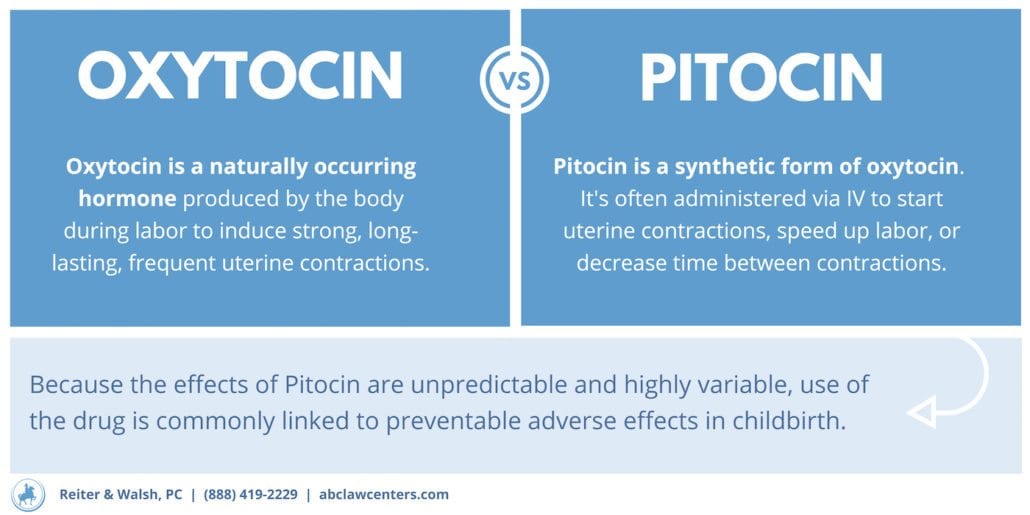Risks of Pitocin (Oxytocin) for Labor Induction
What is pitocin?
Pitocin is a synthetic form of oxytocin, a hormone that induces and strengthens uterine contractions. In a normal pregnancy, oxytocin production should increase naturally during labor and delivery, helping to deliver a baby (1). In certain cases, however, doctors may decide to induce labor. Pitocin can be used to start, strengthen, and make contractions more frequent. In other situations, Pitocin may be used to induce contractions if a pregnant woman does not go into labor on time, her contractions are weak, or there are other complications.
However, Pitocin can be used improperly or can cause contractions to be too strong or too frequent, with too little rest in between. This is known as uterine tachysystole or hyperstimulation.
When this happens, the baby is at risk of not getting enough oxygen because the contractions restrict blood flow between the mother and the baby’s circulatory systems. When the baby does not get enough oxygen, it can suffer birth asphyxia. This can cause subsequent brain injury from hypoxic-ischemic encephalopathy (HIE), or even fetal death.
The mother can also suffer extreme pain, cervical or vaginal lacerations, uterine rupture, and postpartum hemorrhage. Medical staff must be extremely careful to discuss these risks with the mother, only use this drug as indicated, monitor the health of the mother and baby, and quickly intervene if complications arise.

Pitocin vs. Oxytocin: What’s The Difference?
Oxytocin is a hormone that is produced in the body and plays a role in the labor and delivery process. It helps the body to produce contractions and progress through the stages of labor.
Pitocin is a synthetic drug that mimics the effects of oxytocin when given to the mother intravenously (2).

Another difference between Pitocin and oxytocin is the way they move through the body. The posterior pituitary gland in the brain releases oxytocin into the bloodstream in intermittent pulses, which allows the uterus to rest between contractions (3). Because Pitocin is given intravenously, it can be administered continuously, which can then cause the uterus to become hyperstimulated.
Recommended Pitocin Use
Current research does not recommend exceeding established physiologic (normal) levels of uterine activity in order to force a vaginal birth. It is recommended that Pitocin be used for labor induction only when the risk of continuing the pregnancy presents a threat to the life of the baby or mother. In other words, Pitocin is only to be used when it is medically necessary and with continuous fetal monitoring to make sure the baby is getting enough oxygen (2).
Pitocin Risks And Dangers
Pitocin is the drug most commonly associated with preventable adverse events during childbirth (7). In fact, the Institute for Safe Medication Practices includes synthetic oxytocin on its list of “High Alert Medications in Acute Care Settings,” a distinction reserved for only 11 other drugs. The Food and Drug Administration also issued a “black box” warning for Pitocin due to the uncertainty of its benefits compared with its risks (2). The black box label is considered the FDA’s most severe warnings, drawing attention to a drug’s adverse and potentially lethal effects.
The dangerous complications associated with Pitocin primarily stem from two issues associated with its administration: dosage difficulty and hyperstimulation (tachysystole).
Pitocin Dosage Errors
Since the effects of Pitocin vary widely, it should be initiated at a very low dosage. Some women are hypersensitive to it and are likely to experience excessive contractions.
If a patient is given intravenous Pitocin, it must be done through the drip method, and medical staff must continuously monitor it. Electronic fetal monitoring (EFM) is used to detect overdose and whether the baby is getting enough oxygen, but it is important to know that only an intrauterine pressure recording can provide an accurate assessment of pressure and tone in the uterus in between contractions. Doctors should be prepared to quickly discontinue this medication if the health of the mother or baby is in jeopardy.
Hyperstimulation (Tachysystole) From Pitocin
Embedded in the wall of the uterus, the placenta consists of a network of blood vessels, through which oxygen and nutrients flow from mother to baby. When the uterus contracts, the flow of blood and oxygen in or out of the placenta briefly slows or stops. Between contractions, the placenta returns to an “at rest” state, and blood and oxygen again flow freely to the baby. Because contractions reduce the blood and oxygen flow to the baby, there must be enough time between contractions for the placenta to recharge with a fresh supply of blood and oxygen (5). If Pitocin causes contractions that are too long, too strong, too frequent, or there is not enough rest in between contractions, the baby may not get enough oxygen and suffer a brain injury.
Tell us your story.
A birth injury diagnosis is difficult for your family. Secure your child’s future and call the trusted birth injury attorneys at ABC Law Centers: Birth Injury Lawyers.
Pitocin And Birth injuries
If Pitocin is improperly used, or if the drug causes uterine hyperstimulation, it can restrict the oxygen supply to the baby. Oxygen deprivation for too long can lead to brain injury. Some complications associated with the use of Pitocin are:
- Fetal distress
- Abnormal fetal heart rate patterns
- Neonatal (infant) seizures
- Low Apgar scores
- Retinal hemorrhages (abnormal bleeding of the blood vessels in the eye)
- Neonatal jaundice and/or kernicterus
- Hypoxic-ischemic encephalopathy (HIE)
- Brain injury
- Fetal death
Many injuries can occur when physicians attempt to prolong labor and attempt vaginal delivery instead of performing a medically-indicated C-section. It is essential that the medical team involved in labor and delivery be skilled in monitoring to make sure the baby is getting enough oxygen and all obstetrical procedures, and that they follow recommended guidelines and standards of care with regard to the administration of high-risk medications such as Pitocin.
Maternal Injuries From Pitocin
In addition to the many threats it poses to the baby, Pitocin can also put the pregnant patient in danger during and after the labor and delivery process. With both patients at risk it is crucial for physicians to ensure that the decision to proceed with Pitocin induction is not only safe for the baby, but also for the mother. Maternal injuries and complications associated with Pitocin include :
- Strong and prolonged uterine contractions
- Uterine rupture and subsequent hemorrhaging (greater than normal loss of blood after delivery)
- Water intoxication with convulsions (this can occur because Pitocin has antidiuretic effects)
- Subarachnoid hemorrhage (bleeding between the innermost two membranes that cover the brain)
- Cardiac arrhythmias
- Hypertension (high blood pressure)
- Anaphylaxis (a life-threatening allergic reaction)
- Nausea and vomiting
- Pelvic hematoma (accumulation of blood in the soft tissues of the pelvis)
Pitocin And Medical Malpractice
Because of the high-risk nature of Pitocin, there are strict guidelines for the drug’s use. It is mandatory that medical professionals follow these guidelines and only administer Pitocin when it is absolutely necessary. If they do not follow the proper guidelines and an injury occurs, it is medical malpractice. There are certain defined circumstances in which the FDA recommends against the use of Pitocin, including:
- Substantial cephalopelvic disproportion
- Unfavorable fetal position or presentation
- Obstetrical complications that necessitate a C-section delivery, such as:
- Umbilical cord prolapse
- Total placenta previa
- Vasa previa
- Fetal distress without imminent delivery
- There is adequate uterine activity, but unsatisfactory progress in labor
- Hyperactive or hypertonic uterus
- History of hypersensitivity to Pitocin
This is not a complete list of circumstances under which Pitocin and labor induction may be ill-advised. Physicians should also be aware of maternal and fetal risk factors such as the presence of scarring from a previous C-section/uterine surgery, and carefully counsel expectant mothers on various courses of action in order to obtain their informed consent.
The Clinical Opinion On Pitocin
To further ensure that Pitocin is used in a conservative and safe manner, the American Journal of Obstetrics & Gynecology (AJOG) issued a Clinical Opinion in 2009 with the following recommendations for synthetic oxytocin administration (7):
- Pitocin should be started at relatively low doses.
- Proper fetal monitoring must be utilized.
- Contractions are considered acceptable if they have a consistent strength and rate, or there is a consistent pattern of strong contractions every two-three minutes, lasting 80-90 seconds.
- Once acceptable contractions have been met, there is no justification for additional increases in Pitocin dose.
- Pitocin should be aggressively titrated to the lowest dose compatible with sustained levels of appropriate uterine activity.
- Delivery by C-section is indicated when acceptable levels of uterine activity have been met at the lowest dose of Pitocin, but the labor is not progressing in a suitable manner.
Pitocin has long been recognized as a dangerous drug, and the well-being of the fetus may be in jeopardy when induced hyperstimulation occurs during labor. If the medical team treating a mother and baby during labor and delivery does not act in a manner consistent with the standard of care guidelines for the administration of Pitocin, it is negligence. If this negligence results in injury to the baby or mother, it is medical malpractice, for which there may be recovery under the law.
The information presented above is intended only to be a general educational resource. It is not intended to be (and should not be interpreted as) medical advice. If you have questions about Pitocin, please consult with a medical professional.


Get Legal Help
If you suspect that your child’s birth injury resulted from the misuse of Pitocin, it’s critical to choose an attorney and firm that focuses closely on birth injury cases due to the complex nature of the medical records. ABC Law Centers: Birth Injury Lawyers is a national law firm that has exclusively practiced birth injury law since 1997. Our attorneys have won numerous awards for their advocacy of birth-injured children, and are leaders within the Birth Trauma Litigation Group (BTLG) and other leading legal associations.
We have helped obtain compensation for lifelong treatment, therapy, and a secure future for children with birth injuries. Our firm has numerous multi-million dollar verdicts and settlements, and you pay nothing unless we win or obtain a favorable settlement.
Featured Videos
Posterior Position
Hypoxic-Ischemic Encephalopathy (HIE)

Featured Testimonial
What Our
Clients Say…
After the traumatic birth of my son, I was left confused, afraid, and seeking answers. We needed someone we could trust and depend on. ABC Law Centers: Birth Injury Lawyers was just that.
- Michael
Helpful resources
- Oxytocin in pregnancy and the postpartum: relations to labor and its management
- Pitocin® (Oxytocin Injection, USP) Synthetic[PDF]. (2014). FDA.
- Beyond labor: the role of natural and synthetic oxytocin in the transition to motherhood
- High-Alert Medications in Acute Care Settings.
- Marsal, K. (2004). Fetal and placental circulation during labor. Fetal and Neonatal Physiology, 758-758.
- UptoDate: Cervical ripening and induction of labor in women with a prior cesarean birth
- Oxytocin: new perspectives on an old drug


